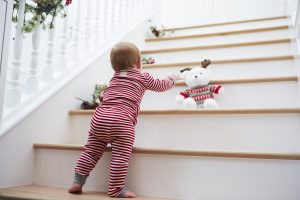When babies start crawling they can move really quickly and get upstairs much faster than you anticipate. To prevent them tumbling or falling back down we recommend having stair gates at the bottom and also at the top of your stairs.
As soon as your baby starts to move! This can be as early as 6-7 months – and it’s a good idea to have them in place before this has started.

Which safety gate you choose depends firstly on where it’s going to go. It’s a good idea to have one at the top and bottom of the stairs, and also into areas of the home with potentially dangerous appliances, like the kitchen.
There are lots of different brands – the thing to watch out for is that they comply with your country’s safety standards.
Have a think about whether there’s room for the gate to swing into when you open it. If not, you might need a roller gate.
Check how easy the gate is to open – remembering sometimes you’ll be doing it with one hand holding a baby or other things –
BUT you don’t want it to open too easily in case you have a toddler fiddling with it…
Screw Fit Gate
These are fixed to the wall with screws.
The advantage is they are really strong and sturdy and there’s no bar across the bottom that might trip you up. These are recommended for the tops of staircases.
The disadvantage is they require drilling into the walls and you can’t easily take them down if you need to.
Pressure Fit Gate
These gates sit in a U shaped frame which is held in place by pressure on the sides. If you have a wide staircase, you can usually get extensions to make the gate wider.
The advantages of these are you don’t have to drill into the walls and you can take them down when you want to.
The disadvantage is the bottom of the U shaped frame can trip you up! For this reason, this design isn’t safe to have at the top of the stairs.
Mesh roller gate
These work like a sideways roller blind. They are great if you don’t have landing space for a grate to open into. They are a bit fiddly though, so a gate is better if there is space.
Which way should the gate open?
For the gate at the top of the stairs, have the gate open towards you – not away from you out over the stairs. Otherwise, you could fall forward whilst opening the gate.
Carrying your baby safely on the stairs
When babies are small they’re obviously completely reliant on you to keep them safe and you need to hold onto the banister as you’re coming down the stairs the same time as you’re holding the baby close to you. Also, have a rule to keep toys off the stairs because as you’re walking down it’s hard to see what’s under foot and you might slip and fall with your baby, and have quite a bad accident.